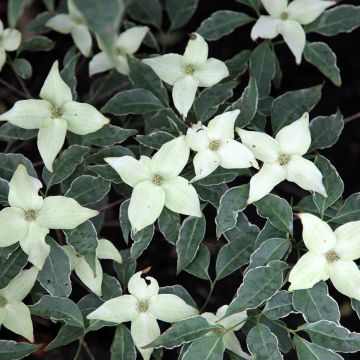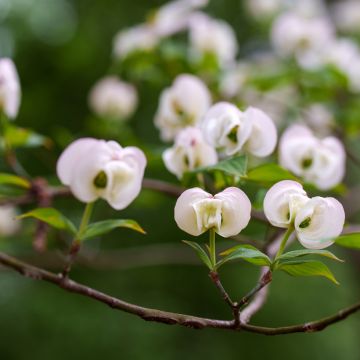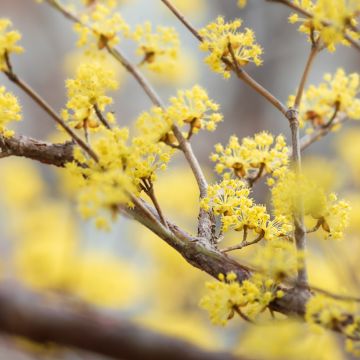

Cornus florida Cherokee Chief - Flowering Dogwood


Cornus florida Cherokee Chief - Flowering Dogwood


Cornus florida Cherokee Chief - Flowering Dogwood


Cornus florida Cherokee Chief - Flowering Dogwood


Cornus florida Cherokee Chief - Flowering Dogwood


Cornus florida Cherokee Chief - Flowering Dogwood


Cornus florida Cherokee Chief - Flowering Dogwood
View more pictures
Hide images

Claude B.

Cornus Florida Cherokee Chief
Claude B. • 56 FR
Cornus florida Cherokee Chief - Flowering Dogwood
Cornus florida Cherokee Chief
Flowering Dogwood, American Dogwood
After ordering around a hundred young plants of all sorts, we are very disappointed! For the price of the plant, we received a branch without a leaf. With little hope, we planted it and the result is unsurprising: not a single leaf, not a single flower. We have a dead branch.
Christophe, 24/05/2023
Special offer!
Receive a €20 voucher for any order over €90 (excluding delivery costs, credit notes, and plastic-free options)!
1- Add your favorite plants to your cart.
2- Once you have reached €90, confirm your order (you can even choose the delivery date!).
3- As soon as your order is shipped, you will receive an email containing your voucher code, valid for 3 months (90 days).
Your voucher is unique and can only be used once, for any order with a minimum value of €20, excluding delivery costs.
Can be combined with other current offers, non-divisible and non-refundable.
Home or relay delivery (depending on size and destination)
Schedule delivery date,
and select date in basket
This plant carries a 24 months recovery warranty
More information
We guarantee the quality of our plants for a full growing cycle, and will replace at our expense any plant that fails to recover under normal climatic and planting conditions.
Would this plant suit my garden?
Set up your Plantfit profile →
Description
Cornus florida 'Cherokee Chief' is a splendid American flowering dogwood, beautiful in spring and stunning in autumn. Forming a compact bush, branched from the base, it produces a dazzling ruby pink flowering in April on its bare branches. In summer, it provides a more subtle display with a green mantle. Then autumn arrives, transforming its foliage into a fiery red-orange blaze. It thrives in non-calcareous soil. It is a very beautiful subject when isolated, in a small garden, or planted in a large ensemble such as a free hedge or a bush grove.
Cornus florida 'Cherokee Chief' is a cultivar derived from the American flowering dogwood, a large flowering shrub native to regions in northeastern North America. It belongs to the Cornaceae family. More compact than the type, 'Cherokee Chief' will reach an average height of 3 m (9.8 ft) with a spread of 2 m (6.6 ft) in our climates, sometimes more. Its habit is rather broad, conical, well-branched, and formed by lateral branches growing horizontally on a single, short, often twisted trunk. From May in cooler regions, (sometimes earlier in mild climates), clusters of small moss green flowers with yellow tips form, ranging from 0.5 to 2 cm (0.2 in to 0.8 in) in length, just before or simultaneously with the appearance of the leaves. They are grouped in clusters (glomerules) and are surrounded by 4 large bracts, 4 cm (1.6 in) long, resembling petals, coloured in dark pink tinged with red. This flowering is more abundant if temperatures are high in summer. In September-October, non-edible red fruits, 1 cm (0.4 in) in diameter, appear scattered over the foliage. The deciduous foliage is composed of green leaves that take on beautiful autumn colours. The leaves measure from 10 cm to 15 cm (3.9 in to 5.9 in) long and are wide, ovate, and pointed. They are often twisted or curled. The bark of young branches and twigs is greenish, tinged with red on their sun-exposed side. With age, it becomes grey and cracks.
'Cherokee Chief' is a very hardy variety, down to -20° C (-4° F). It is better suited to humid climates, which however experience fairly hot summers. It requires a non-calcareous, deep, and moist soil. It is stunning when isolated in small gardens, but also performs well in borders and free hedges. It can be planted alongside other early-flowering shrubs (Hamamelis, Magnolia stellata), fragrant and perpetual lilacs from the Bloomerang series, or mock orange. In an ericaceous bed, it is a perfect companion for rhododendrons and deciduous azaleas.
Cornus florida Cherokee Chief - Flowering Dogwood in pictures




Plant habit
Flowering
Foliage
Botanical data
Cornus
florida
Cherokee Chief
Cornaceae
Flowering Dogwood, American Dogwood
Cultivar or hybrid
Other Cornus
View all →Planting and care
Plant in a sunny or partially shaded environment. It enjoys warmth that helps with its flowering and is sensitive to late spring frosts. It should be placed in a preferably neutral to acidic ordinary soil. The soil should be fertile, moist but well-drained. It can be planted in spring or autumn (frost-free). It is easy to grow when the required conditions are met, and it requires little maintenance. Pruning is not essential. Beware of parasitic attacks such as anthracnose, which can cause severe damage.
Planting period
Intended location
Care
Planting & care advice
-
, onOrder confirmed
Reply from on Promesse de fleurs
Similar products
Haven't found what you were looking for?
Hardiness is the lowest winter temperature a plant can endure without suffering serious damage or even dying. However, hardiness is affected by location (a sheltered area, such as a patio), protection (winter cover) and soil type (hardiness is improved by well-drained soil).

Photo Sharing Terms & Conditions
In order to encourage gardeners to interact and share their experiences, Promesse de fleurs offers various media enabling content to be uploaded onto its Site - in particular via the ‘Photo sharing’ module.
The User agrees to refrain from:
- Posting any content that is illegal, prejudicial, insulting, racist, inciteful to hatred, revisionist, contrary to public decency, that infringes on privacy or on the privacy rights of third parties, in particular the publicity rights of persons and goods, intellectual property rights, or the right to privacy.
- Submitting content on behalf of a third party;
- Impersonate the identity of a third party and/or publish any personal information about a third party;
In general, the User undertakes to refrain from any unethical behaviour.
All Content (in particular text, comments, files, images, photos, videos, creative works, etc.), which may be subject to property or intellectual property rights, image or other private rights, shall remain the property of the User, subject to the limited rights granted by the terms of the licence granted by Promesse de fleurs as stated below. Users are at liberty to publish or not to publish such Content on the Site, notably via the ‘Photo Sharing’ facility, and accept that this Content shall be made public and freely accessible, notably on the Internet.
Users further acknowledge, undertake to have ,and guarantee that they hold all necessary rights and permissions to publish such material on the Site, in particular with regard to the legislation in force pertaining to any privacy, property, intellectual property, image, or contractual rights, or rights of any other nature. By publishing such Content on the Site, Users acknowledge accepting full liability as publishers of the Content within the meaning of the law, and grant Promesse de fleurs, free of charge, an inclusive, worldwide licence for the said Content for the entire duration of its publication, including all reproduction, representation, up/downloading, displaying, performing, transmission, and storage rights.
Users also grant permission for their name to be linked to the Content and accept that this link may not always be made available.
By engaging in posting material, Users consent to their Content becoming automatically accessible on the Internet, in particular on other sites and/or blogs and/or web pages of the Promesse de fleurs site, including in particular social pages and the Promesse de fleurs catalogue.
Users may secure the removal of entrusted content free of charge by issuing a simple request via our contact form.
The flowering period indicated on our website applies to countries and regions located in USDA zone 8 (France, the United Kingdom, Ireland, the Netherlands, etc.)
It will vary according to where you live:
- In zones 9 to 10 (Italy, Spain, Greece, etc.), flowering will occur about 2 to 4 weeks earlier.
- In zones 6 to 7 (Germany, Poland, Slovenia, and lower mountainous regions), flowering will be delayed by 2 to 3 weeks.
- In zone 5 (Central Europe, Scandinavia), blooming will be delayed by 3 to 5 weeks.
In temperate climates, pruning of spring-flowering shrubs (forsythia, spireas, etc.) should be done just after flowering.
Pruning of summer-flowering shrubs (Indian Lilac, Perovskia, etc.) can be done in winter or spring.
In cold regions as well as with frost-sensitive plants, avoid pruning too early when severe frosts may still occur.
The planting period indicated on our website applies to countries and regions located in USDA zone 8 (France, United Kingdom, Ireland, Netherlands).
It will vary according to where you live:
- In Mediterranean zones (Marseille, Madrid, Milan, etc.), autumn and winter are the best planting periods.
- In continental zones (Strasbourg, Munich, Vienna, etc.), delay planting by 2 to 3 weeks in spring and bring it forward by 2 to 4 weeks in autumn.
- In mountainous regions (the Alps, Pyrenees, Carpathians, etc.), it is best to plant in late spring (May-June) or late summer (August-September).
The harvesting period indicated on our website applies to countries and regions in USDA zone 8 (France, England, Ireland, the Netherlands).
In colder areas (Scandinavia, Poland, Austria...) fruit and vegetable harvests are likely to be delayed by 3-4 weeks.
In warmer areas (Italy, Spain, Greece, etc.), harvesting will probably take place earlier, depending on weather conditions.
The sowing periods indicated on our website apply to countries and regions within USDA Zone 8 (France, UK, Ireland, Netherlands).
In colder areas (Scandinavia, Poland, Austria...), delay any outdoor sowing by 3-4 weeks, or sow under glass.
In warmer climes (Italy, Spain, Greece, etc.), bring outdoor sowing forward by a few weeks.



























































